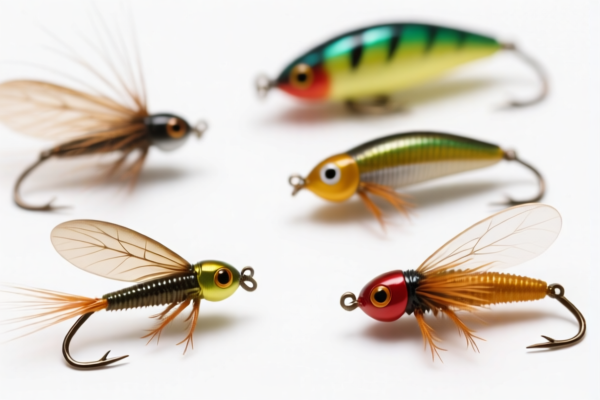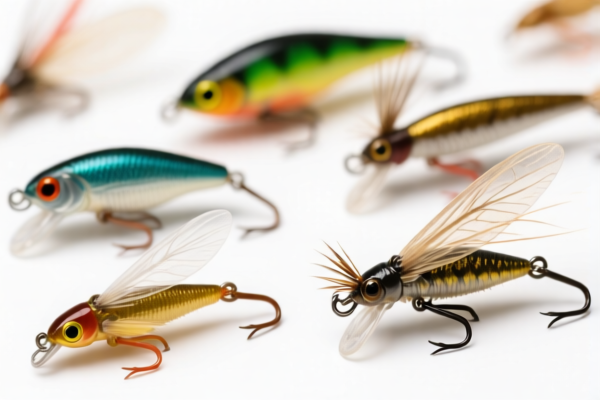| HS Code | Official Doc | Tariff Rate | Origin | Destination | Effective Date |
|---|---|---|---|---|---|
| 9507907000 | Doc | 46.5% | CN | US | 2025-05-12 |
| 9507908000 | Doc | 39.0% | CN | US | 2025-05-12 |
| 3926903500 | Doc | 44.0% | CN | US | 2025-05-12 |
| 3923900080 | Doc | 58.0% | CN | US | 2025-05-12 |




Fishing Lure
A fishing lure is an artificial object used to attract fish. They are typically designed to mimic prey, such as baitfish, crustaceans, insects, or other smaller creatures that fish would naturally consume. Lures are employed when natural bait is unavailable, impractical, or when anglers seek to actively target specific species.
Materials
Lures are constructed from a diverse range of materials, selected for their durability, buoyancy, visual appeal, and ability to imitate movement. Common materials include:
- Metal: Brass, stainless steel, lead (though increasingly restricted due to environmental concerns), zinc alloys are used for body construction, weights, and internal components.
- Plastic: ABS plastic, PVC, and softer plastics like TPE (Thermoplastic Elastomer) are prevalent for body construction, soft plastic baits, and detailing.
- Wood: Balsa wood, cedar, and other hardwoods are used for traditional and custom lures, prized for their buoyancy and unique action.
- Rubber: Used for soft plastic components, skirts, and appendages.
- Fabric/Feathers: Employed for skirts, trailers, and adding visual attraction.
- Paint & Coatings: Used for coloration, UV reflectivity, and protective finishes.
Purpose
The primary purpose of a fishing lure is to entice fish to strike. This is achieved through several mechanisms:
- Visual Attraction: Bright colors, reflective finishes, and realistic patterns mimic prey.
- Movement: Lures are designed to move in a way that resembles the natural actions of prey fish, crustaceans, or insects. This movement is achieved through casting, retrieving techniques, and the lure’s internal construction.
- Sound: Some lures incorporate rattles, clicking sounds, or create vibrations in the water to attract fish.
- Scent: Certain lures are infused with scents that mimic the smell of baitfish or other prey.
Function
Lures function by presenting a tempting target to fish. The angler manipulates the lure through the water using a fishing rod and reel, attempting to trigger a predatory response. The hook, embedded within the lure, secures the fish upon striking.
Usage Scenarios
Lures are utilized in a wide variety of fishing scenarios:
- Freshwater Fishing: Targeting bass, trout, pike, walleye, catfish, and other freshwater species.
- Saltwater Fishing: Targeting tuna, marlin, snapper, grouper, and various coastal species.
- Trolling: Dragging lures behind a boat to cover larger areas.
- Casting: Throwing and retrieving lures from shore, boats, or kayaks.
- Jigging: Vertical presentation of lures, often near structure.
- Ice Fishing: Using smaller lures and jigs through holes in the ice.
Common Types
Lures are categorized based on their design, action, and intended application:
- Crankbaits: Hard-bodied lures that wobble or dive when retrieved, mimicking baitfish. Subcategories include shallow-diving, medium-diving, and deep-diving crankbaits.
- Spoons: Concave metal lures that wobble and flash when retrieved, imitating injured baitfish.
- Spinnerbaits: Lures with a central wire and one or more rotating blades, creating flash and vibration.
- Jigs: Weighted lures with a hook, often with a soft plastic trailer, used for vertical presentation.
- Soft Plastic Baits: Lures made from pliable plastic materials, often rigged on various hook styles. Examples include worms, grubs, swimbaits, and creature baits.
- Topwater Lures: Lures designed to float or move on the water's surface, creating visual and auditory attraction. Examples include poppers, walkers, and prop baits.
- Plugs: Typically larger, hard-bodied lures used for trolling or casting, often mimicking larger prey fish.
- Flies: Lightweight lures designed to imitate insects or small fish, used with specialized fly fishing equipment.
Fishing lures fall under several classifications based on their components and function. Here's a breakdown of relevant HS codes:
- 9507.90.70.00: This code covers “Fishing rods, fish hooks and other line fishing tackle; fish landing nets, butterfly nets and similar nets; decoy "birds" (other than those of heading 9208 or 9705) and similar hunting or shooting equipment; parts and accessories thereof: Other: Other, including parts and accessories: Artificial baits and flies”. This specifically includes artificial baits, which are a core component of many fishing lures. The total tax rate is 46.5%, comprised of a 9.0% base tariff and a 7.5% additional tariff, increasing to 30.0% after April 2, 2025.
- 9507.90.80.00: This code also covers “Fishing rods, fish hooks and other line fishing tackle; fish landing nets, butterfly nets and similar nets; decoy "birds" (other than those of heading 9208 or 9705) and similar hunting or shooting equipment; parts and accessories thereof: Other: Other, including parts and accessories: Other, including parts and accessories”. This is a broader category that can encompass various fishing tackle components, including parts of lures. The total tax rate is 39.0%, consisting of a 9.0% base tariff and a 0.0% additional tariff, rising to 30.0% after April 2, 2025.
- 3926.90.35.00: This code covers “Other articles of plastics and articles of other materials of headings 3901 to 3914: Other: Beads, bugles and spangles, not strung (except temporarily) and not set; articles thereof, not elsewhere specified or included: Other”. If the lure contains plastic beads or spangles as decorative elements, this code may be applicable. The total tax rate is 44.0%, with a 6.5% base tariff and a 7.5% additional tariff, increasing to 30.0% after April 2, 2025.
It is important to note that the specific classification will depend on the lure's composition and function. If the lure is primarily made of plastic, 3926.90.35.00 might be more appropriate. However, if it's considered a complete fishing tackle item, 9507.90.70.00 or 9507.90.80.00 would be more suitable.
Customer Reviews
I found the explanation of the 5% tariff rate very clear. This helped me understand the cost implications for my export plans.
I was impressed with the level of detail on the plastic builder's doors. It's not often you find such specific trade information online.
This page saved me time! The HS code details and tariff rates were all in one place, and it made exporting much easier for me.
The content is useful, but I found the formatting a bit overwhelming. It would be better if the key points were highlighted more.
The information on the 5% tariff rate for plastic doors was exactly what I needed. A bit technical, but accurate and well-explained.